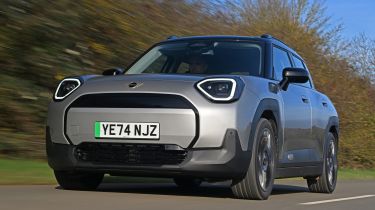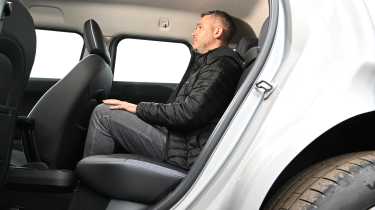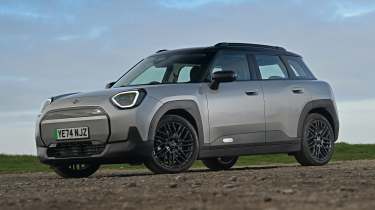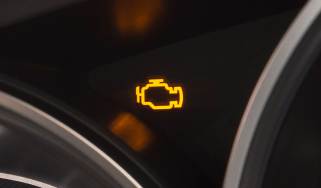MINI Aceman review – a sporty small EV with an upmarket cabin
“Think of the MINI Aceman as a five-door MINI Cooper with a chunky new look and it makes a lot of sense. It’s surprisingly sporty to drive and has a classy interior, but it’s still tight on space”
Pros
- Fun to drive
- Posh interior
- Cheap to run
Cons
- Not very practical
- Firm ride
- Fairly slow public charging
Verdict – is the MINI Aceman a good car?
The MINI Aceman does a lot of things right; it’s fun to drive, looks unique and has a special-feeling interior. Its rear doors will also appeal to MINI drivers who need to carry passengers or child seats in the back, though most rivals offer more rear seat and boot space. We recommend going for the Aceman SE given its longer range over Aceman E cars. However, the Aceman’s firm ride can detract from what is otherwise a very refined EV, but that will be a worthwhile trade-off if you prioritise sportiness over comfort.
MINI Aceman models, specs and alternatives
The MINI Aceman is a completely new model for the beloved British brand. It’s bigger than the MINI Cooper supermini, but a lot smaller than the MINI Countryman, which has grown into a chunky mid-size SUV. While the Aceman has elements of SUV styling, it’s best thought of as a premium five-door hatchback to rival the Volvo EX30, Jeep Avenger and Alfa Romeo Junior.
The other important point is that the Aceman is electric only. MINI doesn’t sell a five-door version of the electric MINI Cooper, so that’s essentially the role that the Aceman fills. It only costs around £1,800 more than an equivalent electric Cooper, so we imagine lots of buyers will upgrade to the larger Aceman, even if it’s just for the rear doors and extra space it offers. Don’t mistake the Aceman for a practical SUV, though. Space in all but the front seats is tight and its boot is quite a bit smaller than a Skoda Fabia’s.
Prices start from around £31,000 for the Aceman E. You get a 43kWh battery, which will last up to 192 miles between charges. For a longer range, you have to upgrade to the Aceman SE, which gets a 54kWh battery and up to 251 miles of range. The flagship John Cooper Works Aceman delivers the most performance, but prices for this model start from over £40,000.
As you’d expect from MINI, there’s lots of personalisation options available on the Aceman, but indulging in the options list can see the price skyrocket in no time. The three trim levels – Classic, Exclusive and Sport – each have slightly different styling and bring more kit than the last. Even the entry-level Classic model gets LED exterior lights, 17-inch alloy wheels and a large circular infotainment touchscreen, so it at least feels well equipped from the get-go.
MINI owners will also be familiar with the extra options that get bundled into packs. There’s now ‘Level 1’ with features like heated seats, a head-up display and wireless phone charging, ‘Level 2’ with a panoramic roof and Harman Kardon stereo and ‘Level 3’ that boosts the spec of Exclusive and Sport trims with massaging front seats, virtual reality navigation and more safety tech. Our test car was an SE model with the Exclusive trim pack and Level 2 options pack, which meant it cost around £41,000 – that feels like a lot for what is essentially a family hatchback.
| Trim levels | Power options |
|
|
Range, charging & running costs
While there’s a war raging between manufacturers to offer EVs with the best range figure, we’re glad MINI has still chosen to offer the Aceman with the option of a smaller 43kWh battery in the ‘E’. If your average weekly mileage is well below 200 miles and you own another car or rarely take long motorway trips, this will save you a lot of money upfront – on a finance deal, however, the gap between their prices can be narrowed quite a bit, so we think it’s worth going for the SE for the added range if you can.
The ‘SE’ version gets a bigger 54kWh capacity, so while its range of up to 252 miles still won’t break any records, it does at least make longer trips more manageable. It’s also fairly competitive with rivals, with the entry-level Alfa Romeo Junior managing 255 miles and the Volvo EX30 spanning from 214 to 296 miles of range depending on the version. If you regularly take long journeys, then the Kia EV3 is probably a better option – it can manage up to 375 miles.
Perhaps another sign that MINI expects most Aceman drivers to charge at home, is its mediocre peak charging speed of 95kW at public charge points. This is just behind the 100kW of the Alfa Romeo Junior, but the Volvo has a peak speed of 153kW. Still, neither Aceman has a huge battery, so a 10-80% top-up should still only take around half an hour.
| Model | Battery size | Range |
| MINI Aceman E | 43kWh | 192 miles |
| MINI Aceman SE | 54kWh | 252 miles |
| MINI Aceman JCW | 54kWh | 242 miles |
How efficient is the MINI Aceman in the real world?
During our first test drive of the MINI Aceman SE in Europe, we managed an average of 3.8 miles/kWh. This took in a mixture of roads, in autumn temperatures of around 10-12 degrees Celsius. On a long motorway haul in the UK, we saw 4.1 miles/kWh in similar temperatures, which was better than expected.
In the Aceman E, we also achieved efficiency figures of 3.8miles/kWh, but because of the smaller battery that equated to just 146 miles on a charge. That felt quite underwhelming, but we were driving the Aceman E in cooler temperatures, high winds and on a challenging test route. It’s worth noting that while the Aceman does get a heat pump as standard, range does seem to vary significantly depending on the outside temperature.
What will the MINI Aceman cost to insure?
While the Aceman is an all-new model, it’s unlikely to cost much more to insure than the MINI Cooper that it’s based on. That should mean insurance groups in the 20-30 range out of 50, matching the Alfa Romeo Junior in groups 23 to 34.
Electric motor, drive & performance
MINI has a reputation for serving up a keen driving experience, and the Aceman certainly delivers. Within seconds of pulling away you’ll be conscious of how direct and connected it feels, while the instant acceleration from the electric motor gives it nippy performance off the line. We think it handles as sharply as the petrol-powered Ford Puma – our class favourite for a long time.
The Aceman’s steering is heavier than you’ll find in most rivals, but it never becomes tiresome. In fact, it adds an extra sense of security when travelling on the motorway, where the Aceman feels very stable. On twistier roads, the steering responds quickly to your inputs and you get the sense there’s an impressive amount of grip on offer. Just like its smaller Cooper sibling, you really can have some fun with it.
There’s also enough instant pulling power in the Aceman to induce a bit of tugging from the steering wheel if you accelerate hard out of corners – a bit like an old school hot hatchback. The Aceman E is no slouch, though, and drives so similarly to the SE that upgrading to it comes more down to its improved range figure than outright performance.
You can adjust the Aceman’s feel with its Core, Green and Go Kart driving modes, switching up how its motor, steering and fake engine sounds behave. The regenerative braking is strong, so you’ll rarely find yourself needing to use the brake pedal, and it can be put into a full one-pedal mode by selecting ‘B’ on the gear selector. It has plenty of bite when you do, which can take some time to get used to, but it ties into the responsive nature of the rest of the driving experience.
Of course, all this fun can’t come without any downsides. In the MINI’s case, it’s a rather firm ride from its suspension. The Aceman felt quite bouncy even on smooth European roads, and things didn’t get much better when we tested it in the UK. It has a tendency to jitter over bumpy roads, transferring even small imperfections in the road through to the cabin. It’s not a deal breaker, but the Volvo EX30 or Kia EV3 will be better options for buyers who prioritise comfort over sportiness, and the Alfa Romeo Junior is a better all-rounder.
Is the MINI Aceman good to drive in town?
The Aceman’s small dimensions, quick steering and brisk acceleration are its biggest assets when driving in town. It’s easy to nip in and out of gaps in traffic, and good all-round visibility helps with navigating city streets and parking. However, this is also where its firm ride frustrates the most, picking out potholes and bumps.
Is the MINI Aceman good to drive on long journeys?
With plenty of power, the Aceman shouldn’t have any trouble passing slower traffic on the motorway or maintaining the national speed limit. There’s a bit of wind noise at higher speeds, but it’s not any worse than rivals and its ride is a bit more settled once up to pace. Its heavy steering helps it to feel stable and secure at high speeds, and its good visibility is useful when merging onto fast roads.
Is the MINI Aceman good to drive on B-roads?
B-roads are arguably where the Aceman makes the most sense, because its chassis feels designed to slice through corners with lots of precision and almost no body lean. If you prefer a car that’s agile and engaging to drive, you shouldn’t be disappointed with the Aceman. Here’s the catch, though – we’re not sure the severe trade-off in ride comfort for sharp driving dynamics is quite worth it for the majority of drivers, and you’ll quickly get sick of how hard it is over rough roads.
| Model | Power | 0-62mph | Top speed |
| MINI Aceman E | 181bhp | 7.9s | 99mph |
| MINI Aceman SE | 215bhp | 7.1s | 105mph |
| MINI Aceman JCW | 254bhp | 6.4s | 124mph |
Carbuyer notes
“The almost sci-fi-like sound crescendos in a pleasing enough way, and changes tone if you push the accelerator pedal past a certain point. It doesn’t attempt to replicate an old-school petrol engine like the Abarth 500e does, but it still offers a level of engagement missing in many rivals.” Richard Ingram, Deputy Editor
Interior & comfort
Very much from the same mould as the MINI Cooper and Countryman, the Aceman’s interior sets the benchmark for quality in a small EV. Materials and its design are top notch, while its circular OLED display also makes it feel really modern, even if it’s a bit frustrating to use. Without a doubt, sitting in the MINI Aceman feels rather special, especially compared with the competition.
Is the MINI Aceman’s infotainment and navigation system easy to use?
The circular infotainment screen – a nod to the old central speedometer found in classic Minis – certainly steals the show. Simply put, it looks fantastic, with a display quality that doesn’t look far behind the latest smartphones and tablets. It’s responsive, too, and comes packed with impressive graphics along with Apple CarPlay and Android Auto.
Our only real gripe is that it’s not very intuitive. Basic tasks like setting a destination in the sat-nav or changing the radio station require more inputs than is ideal, and some functionality is hidden unless you already know where to press. Some of the icons are fairly small, too, and there’s no ledge to rest your hand on when reaching for the screen. Both of these issues make it tricky to use the screen while on the move.
There’s also no separate display for the driver. Without the optional head-up display – part of the £2,000 ‘Level 1’ pack – your speed is only displayed on the central infotainment display, which is out of your sightline when driving. With your speed, navigation, climate controls and more all taking up space on one screen, it can be a bit overwhelming. We think specifying this option is almost a necessity.
If you do decide to use your smartphone connection instead, it won’t quite fill up the circular display, but this is also an issue in many rivals with more conventional screens.
Is the MINI Aceman well equipped?
The Aceman isn’t exactly bargain basement even in entry-level Classic trim, but it does come with LED exterior lighting, roof rails and 17-inch alloy wheels that use 30% recycled material. You also get the large circular infotainment display as standard, along with dual-zone climate control.
Exclusive gives the interior and exterior a makeover, ushering in bigger wheels and a ‘Vibrant Silver’ grille. The choice of paint colours is also expanded from just three in the Classic to six, with the option of two standard wheel designs. Above this sits the Sport trim, with a more athletic appearance that includes new gloss black badges, a contrasting Chili Red roof and white or black bonnet stripes. Sport also gets a rear spoiler with ‘air blades’ and 18-inch or optional 19-inch alloy wheels.
What options should you choose on the MINI Aceman?
MINI has mastered options over the years, and curates them into packs. Here they are called Level 1 to Level 3, with the first bringing a head-up display, Comfort Access, wireless smartphone charging and heated front seats. Level 2 brings a glass roof, tinted rear windows and a Harman Kardon stereo upgrade. For electric front seats with memory and massage functions, advanced parking assist, augmented reality sat-nav and an interior camera you’ll need Level 3.
With no separate driver’s display, we think the head-up display is a must-have option for the Aceman, so it’s a shame that this can’t be optioned individually. Instead, Aceman E customers will need to fork out £2,000 for the Level 1 pack. This pack is at least fitted as standard to the Aceman SE, so think very carefully if you are considering the Aceman E as you may just be better off springing the extra £4,500 for the improved range and level of standard equipment.
Key features | |
|
Classic
|
Exclusive (Classic plus…)
|
|
Sport (Exclusive plus…)
| |
Practicality & boot space
The Aceman’s SUV-style design and slightly raised height can trick the eye into thinking it’s a bigger vehicle, but in reality it’s best to think of it as a five-door version of the MINI Cooper supermini. Measuring just over four metres from bumper to bumper, it’s within a few millimetres of the length of a Volkswagen Polo.
This makes it easy to navigate the city with, fitting easily into parking spots where the Countryman would struggle for room. Swing open the rear doors, and a six-foot-tall adult can just about fit in the back, but the middle seat should only be thought of as a place to sit in a real pinch. Even the compact Jeep Avenger offers more space.
| Size comparison | |||
| Model | Length | Width | Height |
| MINI Aceman | 4,079mm | 1,754mm | 1,514mm |
| Alfa Romeo Junior | 4,173mm | 1,781mm | 1,505mm |
| Volvo EX30 | 4,233mm | 1,836mm | 1,555mm |
| Jeep Avenger | 4,151mm | 1,791mm | 1,531mm |
Does the MINI Aceman have a big boot?
Not exactly, no. Measuring 300 litres, the Aceman has less boot volume than superminis like the Renault Clio and Skoda Fabia. The Vauxhall Mokka Electric, Peugeot E-2008 and Jeep Avenger all offer more space, while the Alfa Romeo Junior has an extra 100 litres behind its back seats. If you are looking at the Aceman as an alternative to the MINI Cooper, though, it does offer a handy 90 litres of extra volume. It’s also a smidge larger than the boot of the petrol-powered MINI Cooper five-door.
During our test, we managed to fit two carry-on suitcases in the boot, but trying to squeeze in a child’s buggy or bicycle would likely be a stretch.
| Boot space comparison | |
| Model | Boot space |
| MINI Aceman | 300 litres |
| Alfa Romeo Junior | 400 litres |
| Volvo EX30 | 318 litres |
| Jeep Avenger | 355 litres |
Reliability & safety
In our latest Driver Power survey, the MINI brand as a whole came 20th out of 32 manufacturers. Not a tremendous result, but one that still places it ahead of premium marques like Mercedes (25th) and Audi in 27th spot.
Things were more positive for the outgoing MINI Hatch, which came a respectable fifth out of the top 50 models ranked by owners. They gave it high scores for handling, but noted its firm ride that’s also likely to be an issue for Aceman owners.
How safe is the MINI Aceman?
The Aceman hasn’t been crash-tested by Euro NCAP yet, but MINI and parent firm BMW have a good reputation when it comes to safety. Despite its small size, the Aceman comes with a host of driver-assistance systems. It’s a shame, however, that some safety features are included in optional packs, and it can be confusing to know exactly what you are getting, so it’s best to check with a salesperson before signing on the dotted line.
What are the MINI Aceman service intervals?
MINI offers a pay monthly servicing plan for electric models, costing £10 per month. This covers the cost of servicing and isn’t affected by inflation or other price rises during the contract. Owners can also take advantage of a four-year servicing deal, including health checks, fluid and filter replacements and the first MoT.
What is the warranty on the MINI Aceman?
The standard warranty lasts for three years and unlimited mileage during that period, also including MINI Roadside Assistance. The battery pack also gets its own warranty lasting for eight years or 100,000 miles, whichever arrives first.
Should you buy a MINI Aceman?
If you are looking for a small, sporty electric car with a range of just over 200 miles, the MINI Aceman could fit the bill perfectly. We suspect a lot of buyers will in fact be people picking the Aceman over the MINI Cooper, thanks to its rear doors and bigger boot.
Buyers looking at other brands from Stellantis or models like the Volvo EX30 may well be tempted by the MINI’s interior. While its design could be polarising thanks to the circular infotainment screen, the quality on offer is first-class, and there’s no denying the Aceman has lots of character and neat touches.
Both the Aceman E and SE offer brisk acceleration, but it’s the sharp handling that really helps it stand out from the pack. MINI has a reputation for making fun cars, and the Aceman is no exception, feeling as responsive as a Ford Puma during our in-depth testing. The flipside of this is that it also has a rather firm ride, so the Aceman isn’t the model to go for if you’re looking solely for comfort.
One of the main reasons to avoid the Aceman is its practicality, or rather, a lack of it. While it may offer an improvement on the MINI Cooper, that’s not saying much – just about all the Aceman’s rivals have more rear legroom and a bigger boot.
What is the best MINI Aceman for low running costs?
Every Aceman avoids VED (road tax) until April 2025 and qualifies for the lowest 2% Benefit-in-Kind (BiK) band for company car choosers. So, if you want to save money, you’ll want to go for the entry-level ‘E’ motor and Classic trim fitted with the smallest 17-inch alloy wheels for the maximum efficiency.
What is the best MINI Aceman for keen drivers?
Driving enthusiasts will want to order the MINI Aceman John Cooper Works, which gets a power increase to 254bhp for a 0-62mph time of 6.4 seconds. We haven’t driven this version yet, however, so we’ll report back as soon as we do. Still, even the entry-level Aceman E offers plenty of fun compared to its rivals.
What is the Carbuyer pick of the MINI Aceman range?
While the Aceman E offers plenty of performance and is just as good to drive as the SE, we still think the SE is the one to go for. It offers a more usable range for buyers, which makes it more versatile, and once you factor in the cost of extras which come as standard on the SE – such as the £2,000 Level 1 pack which comes with the all-important driver’s head-up display – the price gap between the E and SE isn’t as wide as you’d think. Look out for a good finance deal and the gap between them gets even closer.
MINI Aceman alternatives
There is certainly no shortage of rivals here; the small EV class is packed with contenders that all offer different levels of performance, sportiness and practicality.























